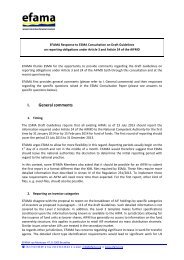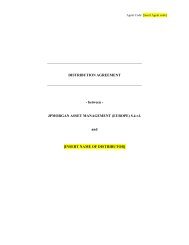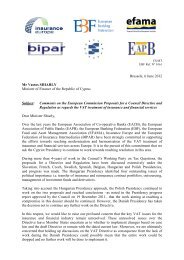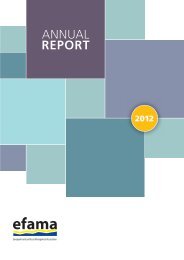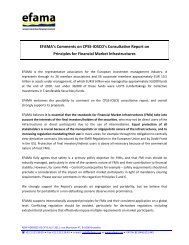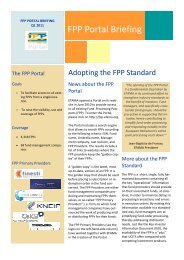EFAMA KPMG Solvency II Report
EFAMA KPMG Solvency II Report
EFAMA KPMG Solvency II Report
You also want an ePaper? Increase the reach of your titles
YUMPU automatically turns print PDFs into web optimized ePapers that Google loves.
4 WORKING GROUP FINDINGS | 53<br />
discussions and it is important that the asset management industry highlights any<br />
potential obstacles that they foresee to insurers so that adequate planning and<br />
preparation can be undertaken in advance of the required changes in asset allocation.<br />
Making the appropriate decisions to change asset allocation requires an adequate<br />
lead time such that an insurer satisfies all of its internal governance procedures.<br />
This task should not be underestimated. For asset managers, implementing these<br />
changes depends on the type of asset and the complexity of the portfolio that needs<br />
to be altered. Timeframes for making asset allocation changes could range from a<br />
few weeks to a number of years. Overlying all of this are market conditions and local<br />
accounting rules, which will dictate the key timing of when changes in asset allocation<br />
will occur.<br />
For now, insurers are typically adopting a ‘wait and see’ approach with regards to<br />
changing their asset allocation. They are concentrating on reviewing their hedges<br />
and derivative holdings and assessing their capital positions as new <strong>Solvency</strong> <strong>II</strong><br />
regulatory updates become available. Lobbying continues on certain key aspects<br />
of the <strong>Solvency</strong> <strong>II</strong> regulations.<br />
There may be a ‘first mover’ advantage for some insurers in altering their asset<br />
allocation in the short-term but this is risky given the important features of the<br />
regulations that are currently being debated and the continued uncertainty that is<br />
prevalent. Any changes in asset allocation that are undertaken in the short-term before<br />
the introduction of <strong>Solvency</strong> <strong>II</strong> will need to be effective under <strong>Solvency</strong> I and <strong>Solvency</strong> <strong>II</strong><br />
for European insurers, whilst UK insurers will also need to consider the impact on their<br />
Internal Capital Assessment (ICA) position.<br />
Given the expected lead time that will be required by insurers before they can<br />
implement their changes in asset allocation, it is important for asset managers to<br />
initiate their interactions with insurers now. Some discussions regarding asset data<br />
will already have taken place with insurers but altering asset allocation, changing<br />
investment mandates and adapting investment strategies are more complicated<br />
activities and require considerable dialogue and interaction between insurers<br />
and asset managers.<br />
The effort and time required to agree and implement these changes should not be<br />
underestimated. Insurers and asset managers will need to communicate with each<br />
other more frequently and this will require some initial investment from both parties<br />
to ensure that an appropriate process is developed such that the volatile economic<br />
balance sheet can be managed and optimised to the benefits of both shareholders<br />
and policyholders.<br />
© 2012 <strong>KPMG</strong> LLP, a UK limited liability partnership, is a subsidiary of <strong>KPMG</strong> Europe LLP and a member fi rm of the <strong>KPMG</strong> network of independent member fi rms affi liated with <strong>KPMG</strong> International<br />
Cooperative, a Swiss entity. All rights reserved.





